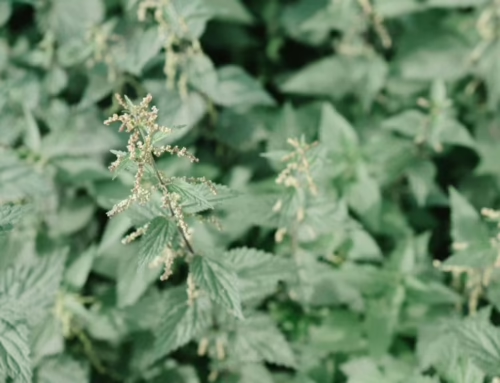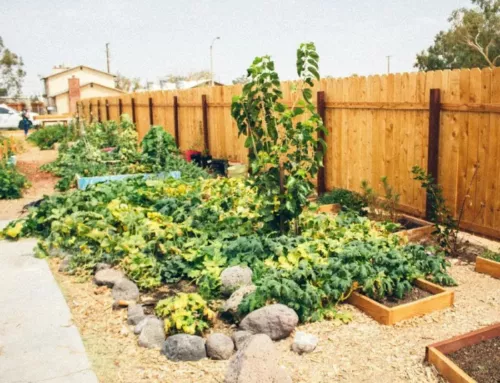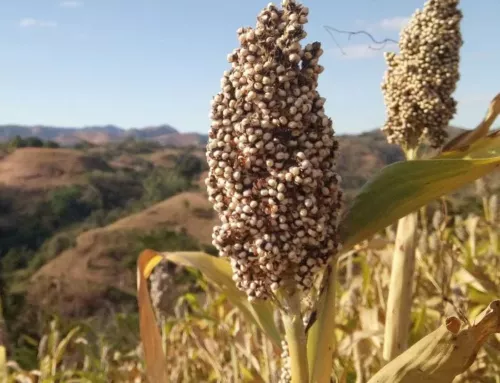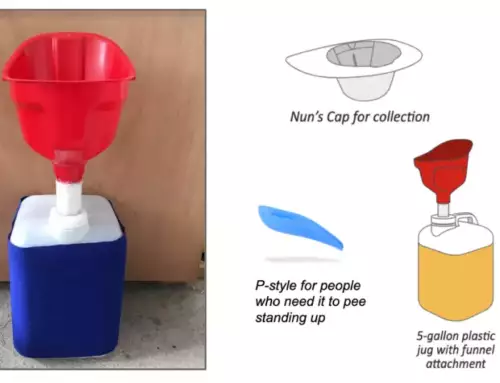By Christy Bassett, NOFA/Mass Dairy Program Coordinator
As more and more people discover the importance of healthy soil in relation to healthy plants, pastures and gardens, many are also discovering that manure is one of a farm’s most valuable resources. Cows, in particular, are extremely efficient converters of mature plant matter into nutrient-rich, highly degradable organic material.
While the percentage of nutrients found in manure can vary greatly from animal to animal due to differences in diet, cow manure is known to be a good source of nitrogen, phosphorus and potassium, all of which are important minerals for future plant growth. While synthetic fertilizers may be more concentrated forms of these minerals, manure includes a high percentage of solid matter, which provides vital carbon compounds that build soil structure.
According to Michigan State University, “Material with a high amount of lignin, or undigested material, will slowly break down over time into active carbon. This active carbon is very important to a healthy soil. It is where nutrient and aggregate glues are found. It also supplies food for the microbial population.” When it comes to increasing your soil organic matter (SOM), it’s hard to beat the addition of animal manure in your plans. But fresh, or raw, manure can cause problems for the local ecosystem if it is not managed properly.
Straight from the cow, manure is so high in nitrogen and ammonia that it can “burn” plants, inhibit seed germination, or encourage tall, leggy plants that never really establish well. It’s also possible for raw manure to carry pathogens, so it is not recommended for use in vegetable gardens or on areas meant for immediate human consumption.
Pastures that are close to bodies of water are also at risk for creating runoff or leaching high levels of nutrients into groundwater from manure build up, which can throw ecosystems out of balance. “Much of the nitrogen in manure is in organic form. This type of nitrogen is not plant-available (more below) and is slowly mineralized by soil microbes into plant-available forms over several years. The rate at which this mineralization happens is dependent on temperature, moisture, and soil microbial activity, all of which cannot be predicted exactly.” [citation] Without proper management, excess nitrogen and phosphorous can be problematic.
There are several ways to responsibly manage manure from livestock and take full advantage of the valuable nutrients it provides. Here we profile three different approaches used by dairy farmers in our community.
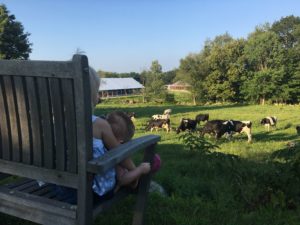
Cows on pasture at Smith’s Country Cheese in Winchendon, MA
Composting
Allie Catlin and family, who own Smith’s Country Cheese and Catlin Farmstead in Winchendon, MA, carry 200 dairy cows on their farm. As is the case on most dairy farms in Massachusetts, the cows graze on lush green grass in the pasture during the day and return to the barn for milking time. As you can imagine, 200 cows can create a lot of manure during their visits to the barn. The Catlins collect this manure daily and return it to their compost pile where they mix it with high carbon wood ash, short paper fiber, and wood chips to balance the carbon-to-nitrogen ratio that is ideal for decomposition.
Balancing the right amount of carbon, nitrogen, water, and air in the pile is important in order for the microorganisms to break down the organic matter efficiently. During this process, the manure will reach a temperature of about 160 degrees F, and then cools down as the process continues. Catlin Farmstead’s compost is aged a minimum of 2 months while it decomposes and transforms into beautiful Black Gold Compost.
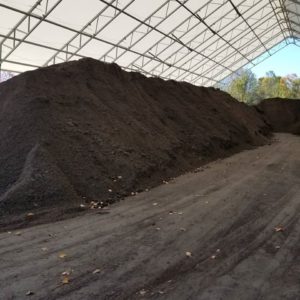
Compost aging at Catlin Farmstead
To compliment the natural aging process, the Catlins received a grant from the State of Massachusetts last year to install a heat recovery system that captures the heat from established compost piles. The system then funnels the heat into fresh piles so that they can age faster. Eventually they hope to use some of this heat to power their barns to most effectively utilize this natural source of energy.
Catlin Farmstead’s Black Gold (straight composted cow manure) is so popular that it completely sold out this spring with the increased demand for home gardening materials. Often customers will also mix the compost with loam for enhancing lawns and pastures.
The Catlins also sell Black Gold Plus, (composted cow manure mixed with peat moss), which retains moisture well for potted plants and containers, and Moo Mulch, which is composted wood chips (similar to bark mulch but coated in compost) for weed control and temperature/moisture retention in gardens.
By collecting and composting their manure, the Catlins are able to control the flow of resources on their property, turn a waste product into a valuable source of nutrients for others growing food in the area, and supplement their milk and cheese income to keep the farm afloat.
Black Gold compost is available at 20 Otter River Road in Winchendon, MA by the bag or truckload, or by delivery. Find out more at https://smithscountrycheese.com/catlinfarmstead/
Planned Grazing
Phyllis and Paul Van Amburgh of Sharon Springs, NY own Dharma Lea Farm, a 700-acre, 100% grass-fed organic dairy farm and Savory Hub. They have about 280 head of primarily Jersey/Ayrshire cattle, with 265 in milk. They utilize their own land for grazing and rent additional land for hay production.
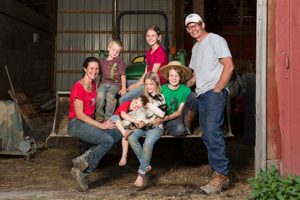
The Van Amburgh family of Dharma Lea Farm
The first producer for Maple Hill Creamery in 2011, Dharma Lea Farm still provides milk for the very successful organic grass-fed dairy company, which produces yogurt and kefir for an ever-expanding conscientious consumer market.
As the founder and director of the Savory Hub, Phyllis is contracted by Maple Hill Creamery to provide direct consultation, training and support to all MHC farmers; currently sixty-two 100% grass-fed dairies, and twenty-six organic, farms. Phyllis’s focus is on production techniques and practices that are regenerative to the landscape, improve farmers’ wellbeing, and promote the health and wellbeing of the cows.
Phyllis and Paul practice Holistic Planned Grazing, a pasture management method that looks at the farm as an ecosystem and encourages farmers to move cows to certain paddocks based on the length and stage of grass growth, nutritional needs of the cows, and behavior of the herd.
As part of their focus on regenerative farming, the Van Amburgh’s watchfully keep eyes on the landscape at all times as they use the land for food production. In 2012, they received a Conservation Innovation Grant, which allowed them to fence out both streams that ran through the center of their grazing areas in order to protect the open water from potential field runoff. This meant that they lost 30 feet of grazing area to buffer zones on either side of the water. But Amburgh states that it “really didn’t matter, as the quality of the pastures has improved dramatically over the years as the cows rotate through”, and they can carry more cows in an allotted space than they were able to previously. Phyllis attributes this increase in grass quality to their lack of tillage and extensive diverse root systems.
The Savory Institute claims that “Holistic Planned Grazing increases the organic matter in the soil and therefore increases its ability to hold water, reducing the risk of floods and droughts. In one study we have seen a 40% increase in water holding capacity on land under Holistic Planned Grazing compared to adjacent land that had no grazing on it.”
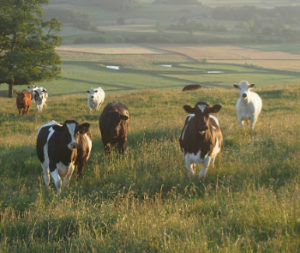
At Dharma Lea, they leave manure to degrade naturally in the fields. They do not drag their pastures to break up or spread manure since they feel it is unnecessary. But it takes a few years to get your soil microbiome to really kick in.
Phyllis relates, “The very first time you send cows through a particular area there are typically no areas that the cows will refuse to eat. The second time around, there are manure or urinated areas that they graze around. By the third time around in August, there are areas of light green and taller patches of dark green where the manure was. But once you go through the winter and send the cows back out again the second year, the microbial system has been established. By the second time that the cows get to a familiar area that second year, about 3 weeks later, the manure has completely re-incorporated into the soil and they have a completely clean slate to graze from. There are no areas that the cows refuse. The nitrogen and nutrients are completely incorporated in a natural way.”
Van Amburgh shares that they never feel the need to fertilize their pastures since the cows are out there maintaining the pastures for them. “When cows bite the grass, the vibrations stimulate the whole root community to grow and there is an uptick in microbial activity. The contact between the cow and the soil is very important.”
Having a healthy root structure and soil microbiome also improves the water holding capacity of the pasture and helps to maintain the temperature of the earth. It is slower to warm in the spring and slower to cool in the fall. Temperature changes are less extreme, which allows for more ideal growing conditions throughout the year and a longer grazing season in general.
According to Phyllis, “it’s not the cow, it’s the how. A lot of people don’t know that the cow rumen and the soil microbiome are almost identical. They have the same pH and share microbial activity. Your cow is a walking incubator for your plant community and soil.”
To learn more about Dharma Lea Farm and Holistic Management, check out this short video.
Anaerobic Digester
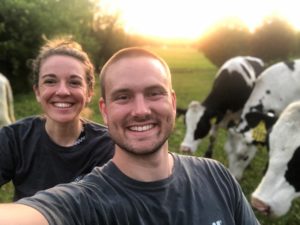
Denise Barstow and Dylan Manz
At Barstow’s Longview Farm in Hadley, MA, Denise Barstow and family have taken a slightly higher tech approach to manure management. With 350 cows and heifers in their dairy herd, they have a bountiful supply of fresh manure each day.
In the fall of 2015, the farm began a partnership with Vanguard Renewables which included the addition of an anaerobic digester. Barstow’s now has one of the largest and most modern anaerobic digestion systems in New England. The zero-waste, closed-loop, farm-powered anaerobic digester converts farm and food waste into electricity, heat, and fertilizer.
The food waste that Barstow’s receives and converts to energy comes from two sources: byproducts of food production from local factories and unsold or unusable food waste from restaurants or grocery stores. All of the food waste received is in a liquid form and arrives in tank trucks who use hoses to empty their loads.
“In Massachusetts, if your business creates more than one ton of food waste per week, it is illegal to put that waste into a landfill. Those companies need to dispose of it somehow, this is a green solution that helps sustain local agriculture at the same time.” says Barstow.
Farm waste includes all of the manure from the farm’s dairy barns, which is diverted and gravity fed into the anaerobic digester. After the manure and food waste have been digested, they are left with a liquid, chemical-free, fertilizer for use on crops and soil. Denise shares “We call it digestate. We spread digestate on the 450 acres of land that we farm between cuttings of hay and corn, so several times a year. We’ve seen increased soil health and crop yields as a result of the digestate and we have decreased our chemical fertilizer usage which saves us money and is better for the environment. We’ve outgrown our feedbunk storage silo while still farming the same number of acres. It’s visibly clear that we are getting more crops from our land thanks to better land practices and the spreading of digestate.”
The manure and food waste cycles out of the digester around every 30 days. Vanguard Renewables manages the digester load so it is as efficient as possible. The anaerobic digester is very similar to a stomach – it is important to keep it fed with the right things since the wrong stuff, or too much of something, will upset it. It’s a balancing act of sorts that involves chemistry and plenty of monitoring.
The microorganisms that break down the waste naturally occur in the cow manure, which is what was needed to get the system started. (Original digesters were designed to run solely on manure. Adding food waste to the mix made it a feasible system for small and medium sized farms to install.) “Now that it’s running and the microorganisms are thriving, the system could feasibly run on only food waste. But we have plenty of manure – and it’s better for the fertilizer – so the digester gets it all!” Barstow tells us.
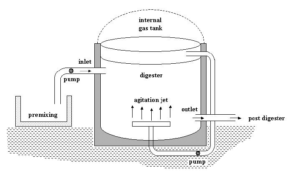
Anaerobic Digester diagram from researchgate.net
“Vanguard Renewables is our partner on this project. They deal with the chemistry, the maintenance, and the food waste contracts. It’s a solution that allows us to focus on farming – milking cows, birthing calves, planting/harvesting crops – and Vanguard Renewables focuses on keeping the digester running and electricity flowing to the grid from our family farm.”
The 2,100 Mwh of electrical energy produced from the digester powers the farm and heats water to warm farm buildings and the family homes. The farm-powered anaerobic digester also provides enough energy to power 1,600 ‘average Massachusetts homes’ in the surrounding community via the Eversource grid and to the Cabot Creamery/Agri-Mark Cooperative butter plant in West Springfield, Massachusetts, to which Barstow’s also supplies milk.
The massive methane engine creates energy by cycling cold water through the engines so that they don’t overheat. Water leaves the engine heated to around 180F. This hot water travels back into the digester, which accelerates the breakdown of food and farm waste (it needs to be over 100F inside the system for the microorganisms to survive).
“The hot water produced is also used to clean the robot milkers in the barn, warm some of the barn floors in the winter, and the hot water travels to 8 homes to provide forced hot water heat in our neighborhood.” shares Denise.
In addition to the amazing renewable energy that this system creates, it also sequesters 85% of the methane produced by cows the farm. “We are currently working with a student at Smith College to calculate our total carbon hoofprint between no-till practices, cover crops, green building at the store, the digester, chemical use, milk production, best practices, etc – so that we can work our way to net 0 (and someday, net positive!)”
Barstow’s Longview Farm received the 2016 Green Pastures Award which is awarded to one outstanding dairy farm in the state. Also in 2016, Cabot Creamery Cooperative won the US Dairy Sustainability Award for Real Farm Power in connection with Barstow’s Anaerobic Digester for Outstanding Dairy Processing & Manufacturing Sustainability. Cabot Creamery Cooperative purchases the renewable energy credits from the farm, which is approximately the amount of energy it takes for them to produce Cabot butter. “Cabot sends us the byproduct of butter/whey powder production from their West Springfield plant, which we turn into electricity for their plant, fertilizer, then food for our cows, and then more milk to make award winning dairy products. It’s a closed loop system!” says Barstow.
To see a video tour of Barstow’s Longview Farm and explanation of how their anaerobic digester works, check out this video from Denise on the NOFA/Mass YouTube Channel.
Learn more about Barstow’s Longview Farm and how you can purchase their milk and bakery items at http://www.barstowslongviewfarm.com/
Denise welcomes you to Barstow’s for great food, beautiful views, and an ongoing conversation about food and food system here in the Pioneer Valley.
For more information on our how dairy farmers in Massachusetts are regenerating the land and being conscientious ecosystem managers, see this month’s related article June is National Dairy Month.
To learn more about how to be a regenerative dairy farmer and/or grazier yourself, attend one of our upcoming educational events.

